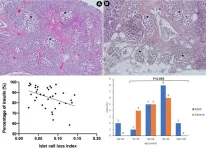Singapore study reveals impact of early life adversity on a child’s brain development
2024-01-15
(Press-News.org)
Leveraging neuroimaging data from the Growing Up in Singapore Towards healthy Outcomes (GUSTO) cohort, researchers from A*STAR’s Singapore Institute for Clinical Sciences (SICS) identified an association between early life adversity and the pace of brain development in childhood.
SINGAPORE – A study led by researchers from A*STAR's Singapore Institute for Clinical Sciences (SICS) has found evidence suggesting that children exposed to elevatec levels of early life adversity (ELA) exhibit an accelerated pattern of brain development during the preschool years. When exposed to ELA, such as a mother's mental and physical health challenges during pregnancy, the child’s brain undergoes accelerated development in order to adapt to the adverse circumstances. This hastened pace of brain development could lead to a higher risk of adverse cognitive and mental health outcomes. The paper, “The influence of early-life adversity on the coupling of structural and functional brain connectivity across childhood” was published in Nature Mental Health on 4 January 2024.
Exposure to ELA is a recognised risk factor for poor health outcomes throughout life. This includes an increased risk of cognitive impairment as well as the development of mental health disorders such as major depressive disorders. Exposure to ELA in the prenatal period triggers changes in the pace of brain development across childhood, most prominent during the preschool period – a crucial time window whereby experience-dependent learning and adaptation set the stage for future brain function. Previous studies suggest that ‘accelerated brain development’ is an adaptive mechanism to early life challenges and may mediate the association between ELA and poor mental health and cognitive outcomes.
To effectively quantify the impact of ELA, the research team adopted a scoring framework created by Professor Patricia Silveira at McGill University, to produce a composite score of ELA which considered factors that extend across a population. These factors focused on exposures experienced before birth, encompassing the mother's mental and physical health during pregnancy as well as the family’s structure and financial circumstances. When we add up or combine different risk factors, it gives us a better prediction of child’s outcome. Using this composite score, the study team stratified the GUSTO cohort into different levels of cumulative ELA exposure. The pace of brain development was then examined across children exposed to different levels of ELA.
To model the pace of brain development across childhood, the study team utilised multi-modal MRI scans from the GUSTO birth cohort. These MRI brain scans were acquired from 549 children at three time-points, ages 4.5, 6.0 and 7.5 years, allowing the study team to examine the link between ELA and brain development in a longitudinal manner. As most mental health disorders have roots in childhood, the study of developmental trajectories in a longitudinal manner is strongly relevant. In this study, a measure which combines structural connectivity and functional connectivity of the brain was used to provide insights into the association between brain structure and function. This measure, known as structure-function coupling (SC-FC), reflects a child’s potential for neuroplasticity, the brain's ability to adapt and reorganise itself to learn, recover from injury, and adjust to new experiences. In early childhood, the brain is expected to be less specialised and more adaptable, matching a decreasing trajectory of SC-FC over childhood.
Led by Dr Tan Ai Peng, Principal Investigator with A*STAR’s SICS and clinician with National University Hospital, along with Dr Chan Shi Yu, a researcher at A*STAR’s SICS, the study found that exposure to high levels of ELA is linked to a faster decline in SC-FC between ages 4.5 and 6, indicating accelerated brain development. This accelerated pattern of brain development is likely an adaptive mechanism when exposed to environmental cues that requires ‘maturity’. Although this is meant to be a ‘protective mechanism’ against adversity, it does have negative implications in the long term as it results in a shorter window of neuroplasticity and adaptive-learning. Notably, results from this study pinpoint the period between ages 4.5 and 6 years as a potential window for early intervention to improve outcomes for children who were exposed to ELA.
“Our study provided evidence that exposure to early-life challenges affects the pace of brain development across childhood. This, in turn, has significant effects on future cognitive and mental health outcomes. If we can develop screening tools to detect accelerated brain development, we will be able to implement interventions earlier, and prevent cascading consequences of accelerated brain development for mental health.” said, Dr Tan Ai Peng
Already looking forward, the researchers have identified important areas for future investigation – determining whether ELA’s effects on accelerated brain development across childhood set the stage for premature brain ageing in later stages of life, and the effectiveness of intervention strategies that could mitigate the effects of ELA exposure such as the promotion of psychological resilience through cognitive behavioural therapy.
END
ELSE PRESS RELEASES FROM THIS DATE:
2024-01-15
A team of researchers has developed a new scoring system for a nationwide scheme, overseen by the Advisory Committee on Clinical Impact Awards (ACCIA), to recognise and reward senior doctors and dentists in England and Wales.
There has been a scheme in place since 1948 to reward senior clinicians who make an outstanding contribution to supporting the delivery of NHS goals. The awards have been known, through various iterations, as merit awards, clinical excellence awards, and, most recently, clinical impact awards.
Published ...
2024-01-14
Only a small percentage of older Americans have jumped on the rising trend of getting health care services and prescriptions directly from an online-only company, rather than seeing their usual health care providers in person or via telehealth, a new poll finds.
But that could change rapidly, the University of Michigan survey suggests.
In all, 7.5% of people between the ages of 50 and 80 have used at least one direct-to-consumer health care service from an online-only provider, according to the new findings from the National Poll on Healthy Aging.
Of those who did ...
2024-01-13
Tokyo, Japan – Researchers from Tokyo Metropolitan University have studied pancreatic islet cell loss in people with no previous pancreatic problems. They identified key trends in the types of cells lost due to islet cell loss in different age groups and sexes, finding that ICL in the elderly population was largely due to insulin-producing beta cell loss. This may be the cause of age-related diabetes and help inform new preventative treatments.
The pancreas is an incredibly important part of the human digestive system, particularly for regulating blood sugar levels by secreting the hormone insulin. ...
2024-01-13
In women living with HIV, preventive treatment with DHA-PPQ is a safe and effective strategy to prevent malaria during pregnancy, according to the final results of MAMAH, a clinical trial funded by the European & Developing Countries Clinical Trials Partnership (EDCTP) and coordinated by the Barcelona Institute for Global Health (ISGlobal), an institution supported by “la Caixa” Foundation. The study, published in the Lancet Infectious Diseases, could help protect the health of the estimated one million pregnant women who suffer from a double infection with malaria ...
2024-01-13
Innovation may be what drives progress in the arts, business, sciences and technology, but the novel ideas that drive innovation often face headwinds that hinder or even prevent their adoption.
Why did some good ideas, such as hand sanitizing in 19th-century hospitals or racial integration in the 20th century, take years to win widespread embrace? University of Utah postdoctoral researcher Wayne Johnson set out to identify the hurdles.
His research team’s program of five studies, which featured analyses of evaluations of films screened at Utah’s Sundance Film ...
2024-01-13
Insects and spiders often receive little attention from people, except when we’re swatting them away. However, as arthropods — creatures distinguished by a hard exoskeleton and jointed legs— they play an essential role in sustaining the ecosystems humans rely on. Remarkably, arthropods make up approximately 84% of all known animal species.
A study published recently in Scientific Reports reveals how human activity affects biodiversity among arthropods and how nonbiological factors, such as daily temperature swings and proximity to the ocean, affect arthropod biodiversity in urban areas.
The research uncovered a few ...
2024-01-12
Researchers in the Department of Anesthesia and Perioperative Medicine at the Medical University of South Carolina (MUSC) have found that an FDA-approved drug may help to decrease pain after surgery. In the pilot study published in Pain Management, spinal surgery patients who received N-acetylcysteine (NAC) during surgery in addition to standard pain control treatments reported lower pain scores and requested fewer opioids after surgery than patients given a placebo.
Opioids are often given for a short time after ...
2024-01-12
(Memphis, Tenn – January 12th, 2024) The protein HOXA9 is overexpressed in most acute myeloid leukemia (AML) cases and is associated with poor patient outcomes. However, HOXA9 is a difficult protein to target therapeutically, so researchers at St. Jude Children’s Research Hospital looked for ways to extinguish it indirectly. Using CRISPR/Cas9 screening, the researchers identified RBM5, demonstrating a causative link between RBM5 expression and leukemia cell proliferation. This link is driven by a novel dual function of RBM5 as both a DNA and RNA handler ...
2024-01-12
A new study led by researchers at the University of Chicago found that changes in male gender expression from adolescence to young adulthood align closely with the gender norms present in individuals’ school environments, and that these trajectories are associated with subsequent patterns of substance abuse.
Amidst a growing consensus among social science researchers that separates gender from biological sex, gender has come to be defined as a constellation of expected behaviors, attributes, preferences and beliefs typically associated with a specific gender identity. Prior research shows that traditional models of male gender identity, constructed over time through sociocultural ...
2024-01-12
LEXINGTON, Ky. (Jan. 12, 2024) — Larry Goldstein, M.D., chair of the University of Kentucky Department of Neurology, has been selected to serve as co-chair of The Kentucky Heart Disease and Stroke Prevention (KHDSP) Task Force representing stroke systems of care across the state.
Goldstein is co-director of the Kentucky Neuroscience Institute, co-director of the UK Neuroscience Research Priority Area, contact PI for the state’s CDC Coverdell National Acute Stroke Program grant, and interim director of the UK-Norton Healthcare Stroke Care Network. Additionally, he also sits on ...
LAST 30 PRESS RELEASES:
[Press-News.org] Singapore study reveals impact of early life adversity on a child’s brain development


